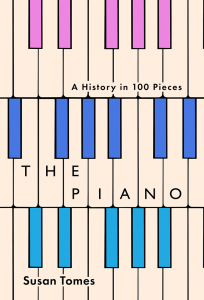 I haven’t said much about my new book during the past year. In the midst of such upheaval it seemed unwise to count on things going as planned. But happily it’s not long now until The Piano – a History in 100 Pieces is published by Yale University Press on July 13th. The date has shone brightly in my imagination during the dark year of lockdown. Almost all my concerts had been cancelled – but I had this book to look forward to!
I haven’t said much about my new book during the past year. In the midst of such upheaval it seemed unwise to count on things going as planned. But happily it’s not long now until The Piano – a History in 100 Pieces is published by Yale University Press on July 13th. The date has shone brightly in my imagination during the dark year of lockdown. Almost all my concerts had been cancelled – but I had this book to look forward to!
My previous books have been concerned with performance. I hadn’t focused specifically on repertoire – for a long time I felt that there were lots of people who had done that, were doing that and could do it better than I could. After all, I’m not a historian or a musicologist. But gradually I began to see that I had other qualifications. My experience of playing, rehearsing, performing and recording these pieces has given me a wealth of knowledge about them – not academic knowledge, but what one might call ‘embodied knowledge’, accumulated during years of grappling with piano parts and sharing them with concert audiences.
My original plan was to pick a favourite area of piano repertoire and explore it in great detail. But I worried that such a book would be of limited appeal. I wanted to write something of wider interest. How to do that without spreading myself so thinly that my remarks about any particular piece seemed glib and inadequate? Then someone gave me a present of Neil MacGregor’s History of the World in 100 Objects, which has delighted many readers. As I browsed through it I wondered if the same approach could be taken to piano music.
Putting the idea into practice was tricky. What criteria should I use to pick the pieces – my own favourites, or tried and trusted masterpieces? Where should I begin? Should I stick to ‘important’ pieces, or was it OK to include little gems, oddities, provocations? My first attempt, based on my favourites, produced a frankly lopsided list with about 30 pieces by Mozart, 20 by Schubert, 20 by Schumann, 20 by Debussy and Ravel, and so on. This wouldn’t do. I had to take a step back and be more objective.
I spent a lot of time shoving around pieces of paper with the names of pieces on them, making mosaics on the floor before I found a pattern which seemed to tell a meaningful story. I decided to start at the point where the harpsichord was supplanted by the piano. That moment in history felt important because as the piano developed, its greater tonal variety inspired a different type of music. To keep my choices to 100, I found that I sometimes had to cheat a bit and include ‘sets’, such as Chopin Preludes or Debussy Preludes, rather than artificially pick out just one. I didn’t feel too badly about this – after all, a symphony can easily last for an hour, but everyone would agree it is just ‘one piece’. So why not allow a 40-minute set of preludes to count as one choice?
Although I tried to be objective, my 100 pieces inevitably reflect my character and interests. Solo pieces occupy the lion’s share, but my love of chamber music led me to include many collaborative pieces which I believe are the best of their composers’ work. My love for jazz made me include some of that too. I’m sure that being a woman has influenced my approach. Above all, the fact that I’m a pianist has stamped itself upon my choices. I know how a lot of this stuff feels under the hands, how it finds a home in the imagination. I have experience of what it’s like to try to give it shape and bring it to life in front of listeners, and it was a great pleasure to describe it.




Fabulous – July 13th going in the diary!
Congratulations!
I can’t wait! I hope the Schumann Fantasie in C is included 😛
No, the Schumann Fantasie in C isn’t included, James – not because I don’t love it, but because its middle movement is so problematic – for pianists especially! I’ve always thought the Fantasie shows the best and worst of Schumann … the first movement is inspired in parts, the second movement is bombastic, and the third movement is one of the most touching things he wrote.
I love reading about musicians talking about music that they adore. Your own solo repertoire is quite private – I can’t wait to read about your thoughts.
Perhaps for a next book, ‘100 pieces that I don’t really like!’